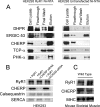Identification of novel ryanodine receptor 1 (RyR1) protein interaction with calcium homeostasis endoplasmic reticulum protein (CHERP)
- PMID: 21454501
- PMCID: PMC3089550
- DOI: 10.1074/jbc.M110.197186
Identification of novel ryanodine receptor 1 (RyR1) protein interaction with calcium homeostasis endoplasmic reticulum protein (CHERP)
Abstract
The ryanodine receptor type 1 (RyR1) is a homotetrameric Ca(2+) release channel located in the sarcoplasmic reticulum of skeletal muscle where it plays a role in the initiation of skeletal muscle contraction. A soluble, 6×-histidine affinity-tagged cytosolic fragment of RyR1 (amino acids 1-4243) was expressed in HEK-293 cells, and metal affinity chromatography under native conditions was used to purify the peptide together with interacting proteins. When analyzed by gel-free liquid chromatography mass spectrometry (LC-MS), 703 proteins were identified under all conditions. This group of proteins was filtered to identify putative RyR interacting proteins by removing those proteins found in only 1 RyR purification and proteins for which average spectral counts were enriched by less than 4-fold over control values. This resulted in 49 potential RyR1 interacting proteins, and 4 were selected for additional interaction studies: calcium homeostasis endoplasmic reticulum protein (CHERP), endoplasmic reticulum-Golgi intermediate compartment 53-kDa protein (LMAN1), T-complex protein, and phosphorylase kinase. Western blotting showed that only CHERP co-purified with affinity-tagged RyR1 and was eluted with imidazole. Immunofluorescence showed that endogenous CHERP co-localizes with endogenous RyR1 in the sarcoplasmic reticulum of rat soleus muscle. A combination of overexpression of RyR1 in HEK-293 cells with siRNA-mediated suppression of CHERP showed that CHERP affects Ca(2+) release from the ER via RyR1. Thus, we propose that CHERP is an RyR1 interacting protein that may be involved in the regulation of excitation-contraction coupling.
Figures





Similar articles
-
Triadin binding to the C-terminal luminal loop of the ryanodine receptor is important for skeletal muscle excitation contraction coupling.J Gen Physiol. 2007 Oct;130(4):365-78. doi: 10.1085/jgp.200709790. Epub 2007 Sep 10. J Gen Physiol. 2007. PMID: 17846166 Free PMC article.
-
Efficient High-Throughput Screening by Endoplasmic Reticulum Ca2+ Measurement to Identify Inhibitors of Ryanodine Receptor Ca2+-Release Channels.Mol Pharmacol. 2018 Jul;94(1):722-730. doi: 10.1124/mol.117.111468. Epub 2018 Apr 19. Mol Pharmacol. 2018. PMID: 29674523
-
The cytoplasmic loops between domains II and III and domains III and IV in the skeletal muscle dihydropyridine receptor bind to a contiguous site in the skeletal muscle ryanodine receptor.J Biol Chem. 1998 Nov 6;273(45):29958-64. doi: 10.1074/jbc.273.45.29958. J Biol Chem. 1998. PMID: 9792715
-
Control of muscle ryanodine receptor calcium release channels by proteins in the sarcoplasmic reticulum lumen.Clin Exp Pharmacol Physiol. 2009 Mar;36(3):340-5. doi: 10.1111/j.1440-1681.2008.05094.x. Clin Exp Pharmacol Physiol. 2009. PMID: 19278523 Review.
-
Complex interactions between skeletal muscle ryanodine receptor and dihydropyridine receptor proteins.Biochem Cell Biol. 1998;76(5):681-94. doi: 10.1139/bcb-76-5-681. Biochem Cell Biol. 1998. PMID: 10353700 Review.
Cited by
-
Nuclear ALG-2 protein interacts with Ca2+ homeostasis endoplasmic reticulum protein (CHERP) Ca2+-dependently and participates in regulation of alternative splicing of inositol trisphosphate receptor type 1 (IP3R1) pre-mRNA.J Biol Chem. 2013 Nov 15;288(46):33361-75. doi: 10.1074/jbc.M113.497479. Epub 2013 Sep 27. J Biol Chem. 2013. PMID: 24078636 Free PMC article.
-
Endoplasmic reticulum resident protein 44 (ERp44) deficiency in mice and zebrafish leads to cardiac developmental and functional defects.J Am Heart Assoc. 2014 Oct 20;3(5):e001018. doi: 10.1161/JAHA.114.001018. J Am Heart Assoc. 2014. PMID: 25332179 Free PMC article.
-
TP53I11 Functions Downstream of Multiple MicroRNAs to Increase ER Calcium Levels and Inhibits Cancer Cell Proliferation.Int J Mol Sci. 2024 Dec 24;26(1):31. doi: 10.3390/ijms26010031. Int J Mol Sci. 2024. PMID: 39795889 Free PMC article.
-
AKAP6 and phospholamban colocalize and interact in HEK-293T cells and primary murine cardiomyocytes.Physiol Rep. 2019 Jul;7(14):e14144. doi: 10.14814/phy2.14144. Physiol Rep. 2019. PMID: 31325238 Free PMC article.
-
Genetic Polymorphism in the RYR1 C6487T Is Associated with Severity of Hypospadias in Chinese Han Children.Biomed Res Int. 2018 Jun 20;2018:7397839. doi: 10.1155/2018/7397839. eCollection 2018. Biomed Res Int. 2018. PMID: 30027098 Free PMC article.
References
-
- Berchtold M. W., Brinkmeier H., Müntener M. (2000) Physiol. Rev. 80, 1215–1265 - PubMed
-
- Loke J., MacLennan D. H. (1998) Am. J. Med. 104, 470–486 - PubMed
-
- MacLennan D. H., Phillips M. S. (1992) Science 256, 789–794 - PubMed
-
- MacLennan D. H. (2000) Eur. J. Biochem. 267, 5291–5297 - PubMed
-
- MacLennan D. H., Kranias E. G. (2003) Nat. Rev. Mol. Cell Biol. 4, 566–577 - PubMed
Publication types
MeSH terms
Substances
Grants and funding
LinkOut - more resources
Full Text Sources
Other Literature Sources
Molecular Biology Databases
Miscellaneous

